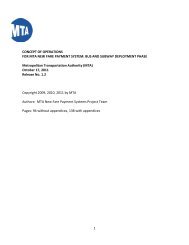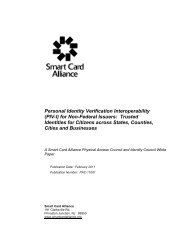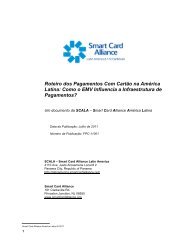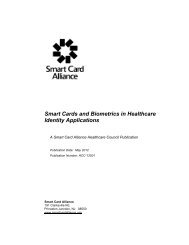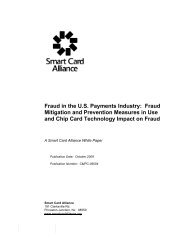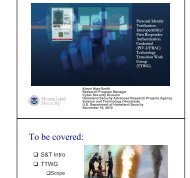Physical Access Control Systems and FIPS 201 Physical Access ...
Physical Access Control Systems and FIPS 201 Physical Access ...
Physical Access Control Systems and FIPS 201 Physical Access ...
You also want an ePaper? Increase the reach of your titles
YUMPU automatically turns print PDFs into web optimized ePapers that Google loves.
PACS Readers: <strong>FIPS</strong> <strong>201</strong><br />
Requirements<br />
<br />
<br />
<br />
<br />
<br />
<strong>FIPS</strong> <strong>201</strong> defaults to PACS 2.2 for access control – low, medium <strong>and</strong><br />
high assurance profiles.<br />
There is not a requirement to read <strong>and</strong> output the entire CHUID to open<br />
a door.<br />
Reading the entire CHUID would add more time to the actual transaction <strong>and</strong><br />
could not all be processed by modern day access control systems.<br />
Enough information should be read to output either the FASC-N or the<br />
GUID <strong>and</strong> to be able to calculate the HMAC for a higher level of<br />
assurance. If the highest assurance security level is required, the<br />
reader will also need to be capable of symmetric or asymmetric<br />
keying. Another option would be passing the card certificate from the<br />
contact chip.<br />
Whether ISO 14443 is used for contactless or ISO 7816 is used for<br />
contact chips, output to the access control panels should remain the<br />
same since the same CHUID data is used through either interface.<br />
Read speed is not believed to be an issue if the system is only reading<br />
<strong>and</strong> outputting the FASC-N/GUID alone or with the HMAC. Read speed<br />
may be an issue with reading/verifying very large biometric images or<br />
meeting higher security assurance profiles.<br />
16







